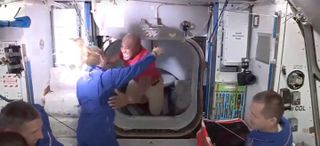
Victor Glover just made history.
Early Tuesday morning (Nov. 17), the 44-year-old NASA astronaut came aboard the International Space Station, becoming the first African American ever to begin a full six-month stint on the orbiting lab.
Glover and three crewmates — fellow NASA astronauts Mike Hopkins and Shannon Walker and Japan's Soichi Noguchi — left Earth on Sunday evening (Nov. 15) aboard the SpaceX Crew Dragon capsule "Resilience." The launch kicked off Crew-1, SpaceX's first-ever contracted, fully operational astronaut mission to the space station for NASA.
SpaceX's Crew-1 astronaut launch for NASA: Live updates
Crew-1 is even more historic thanks to Glover's milestone, which is long overdue considering that rotating astronaut crews have been living aboard the orbiting lab continuously for 20 years now. In typical astronaut fashion, Glover has been self-effacing about his place in history, deflecting the spotlight onto his crewmates and the other people who have worked hard to make Crew-1 a success.
"It is something to be celebrated once we accomplish it, and, you know, I am honored to be in this position and to be a part of this great and experienced crew," Glover said during a news conference last week, before Crew-1 got off the ground. "And I look forward to getting up there and doing my best to make sure that, you know, we are worthy of all the work that's been put into setting us up for this mission."
Glover isn't the first African American astronaut to spend time on the station. A handful of others visited the orbiting lab during space shuttle missions, but those were brief jaunts lasting just a few weeks. Glover will spend more than six months in orbit, serving as a crewmember on the space station's Expedition 64 and Expedition 65 missions.
Get the Space.com Newsletter
Breaking space news, the latest updates on rocket launches, skywatching events and more!
As The New York Times noted, more than 300 NASA astronauts have reached space to date, but Glover is just the 15th African American member of this exclusive club. (Crew-1 is the first spaceflight for Glover, a U.S. Navy commander and pilot who was selected as an astronaut in 2013.) The 16th should join soon: Jeanette Epps will ride Boeing's CST-100 Starliner capsule on its first operational mission to the space station, which is scheduled to launch sometime next year.
Both SpaceX and Boeing signed multibillion-dollar deals in 2014 with NASA's Commercial Crew Program, which has encouraged the development of private astronaut taxis to fill the shoes of the retired space shuttles. SpaceX is now fully up and running in this regard, but Starliner still needs to ace an uncrewed test flight to the station before it can carry astronauts.
Starliner already took one crack at this uncrewed mission in December 2019 but suffered a glitch that stranded the capsule in an orbit too low for a rendezvous. Boeing aims to launch attempt number two early next year; success would help pave the way for the mission of Epps and her crewmates.
Mike Wall is the author of "Out There" (Grand Central Publishing, 2018; illustrated by Karl Tate), a book about the search for alien life. Follow him on Twitter @michaeldwall. Follow us on Twitter @Spacedotcom or Facebook.
Join our Space Forums to keep talking space on the latest missions, night sky and more! And if you have a news tip, correction or comment, let us know at: community@space.com.

Michael Wall is a Senior Space Writer with Space.com and joined the team in 2010. He primarily covers exoplanets, spaceflight and military space, but has been known to dabble in the space art beat. His book about the search for alien life, "Out There," was published on Nov. 13, 2018. Before becoming a science writer, Michael worked as a herpetologist and wildlife biologist. He has a Ph.D. in evolutionary biology from the University of Sydney, Australia, a bachelor's degree from the University of Arizona, and a graduate certificate in science writing from the University of California, Santa Cruz. To find out what his latest project is, you can follow Michael on Twitter.
